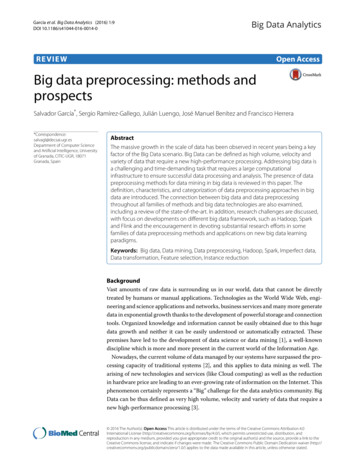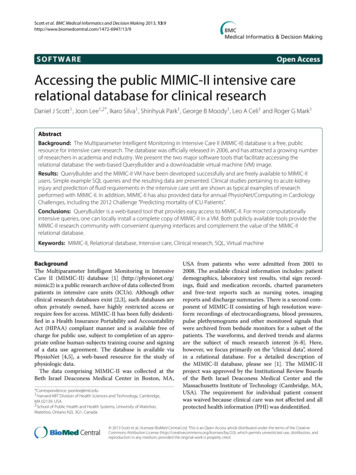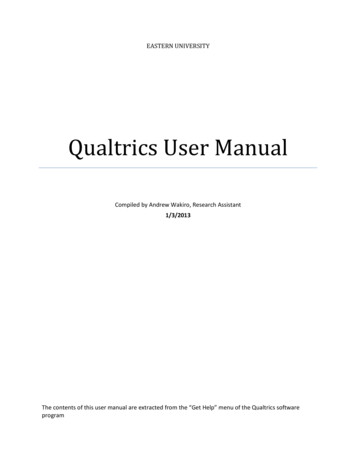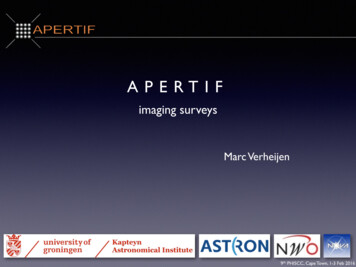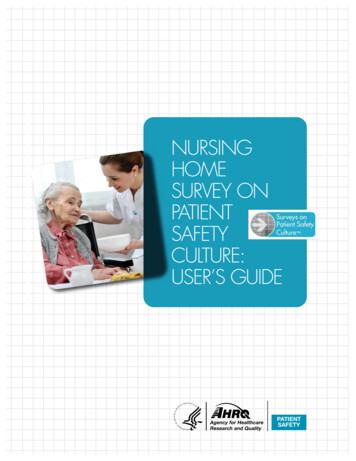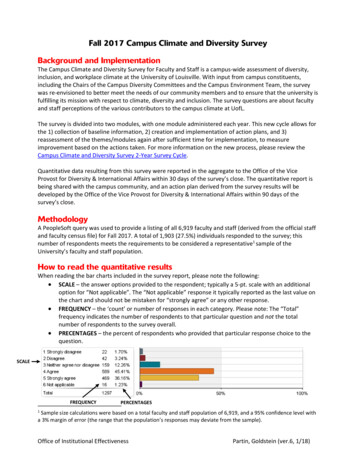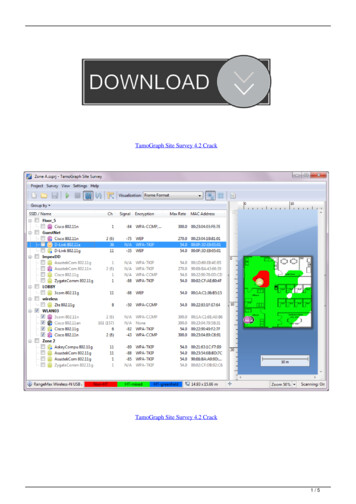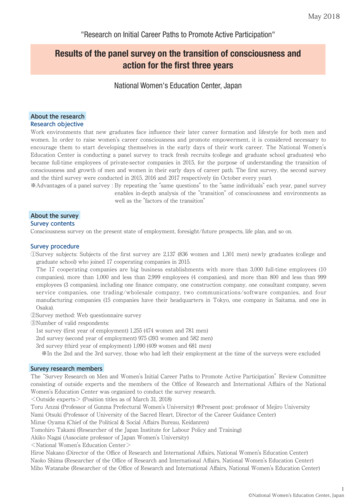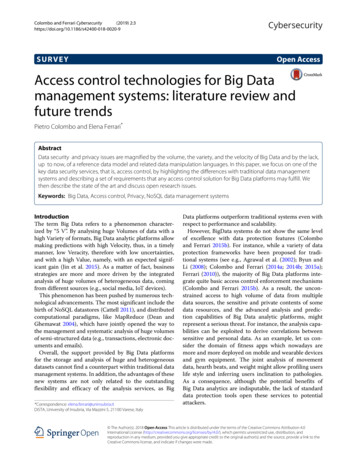
Transcription
Cybersecurity(2019) 2:3Colombo and Ferrari 20-9S UR V EYOpen AccessAccess control technologies for Big Datamanagement systems: literature review andfuture trendsPietro Colombo and Elena Ferrari*AbstractData security and privacy issues are magnified by the volume, the variety, and the velocity of Big Data and by the lack,up to now, of a reference data model and related data manipulation languages. In this paper, we focus on one of thekey data security services, that is, access control, by highlighting the differences with traditional data managementsystems and describing a set of requirements that any access control solution for Big Data platforms may fulfill. Wethen describe the state of the art and discuss open research issues.Keywords: Big Data, Access control, Privacy, NoSQL data management systemsIntroductionThe term Big Data refers to a phenomenon characterized by “5 V”. By analysing huge Volumes of data with ahigh Variety of formats, Big Data analytic platforms allowmaking predictions with high Velocity, thus, in a timelymanner, low Veracity, therefore with low uncertainties,and with a high Value, namely, with an expected significant gain (Jin et al. 2015). As a matter of fact, businessstrategies are more and more driven by the integratedanalysis of huge volumes of heterogeneous data, comingfrom different sources (e.g., social media, IoT devices).This phenomenon has been pushed by numerous technological advancements. The most significant include thebirth of NoSQL datastores (Cattell 2011), and distributedcomputational paradigms, like MapReduce (Dean andGhemawat 2004), which have jointly opened the way tothe management and systematic analysis of huge volumesof semi-structured data (e.g., transactions, electronic documents and emails).Overall, the support provided by Big Data platformsfor the storage and analysis of huge and heterogeneousdatasets cannot find a counterpart within traditional datamanagement systems. In addition, the advantages of thesenew systems are not only related to the outstandingflexibility and efficacy of the analysis services, as Big*Correspondence: elena.ferrari@uninsubria.itDiSTA, University of Insubria, Via Mazzini 5, 21100 Varese, ItalyData platforms outperform traditional systems even withrespect to performance and scalability.However, BigData systems do not show the same levelof excellence with data protection features (Colomboand Ferrari 2015b). For instance, while a variety of dataprotection frameworks have been proposed for traditional systems (see e.g., Agrawal et al. (2002); Byun andLi (2008); Colombo and Ferrari (2014a; 2014b; 2015a);Ferrari (2010)), the majority of Big Data platforms integrate quite basic access control enforcement mechanisms(Colombo and Ferrari 2015b). As a result, the unconstrained access to high volume of data from multipledata sources, the sensitive and private contents of somedata resources, and the advanced analysis and prediction capabilities of Big Data analytic platforms, mightrepresent a serious threat. For instance, the analysis capabilities can be exploited to derive correlations betweensensitive and personal data. As an example, let us consider the domain of fitness apps which nowadays aremore and more deployed on mobile and wearable devicesand gym equipment. The joint analysis of movementdata, hearth beats, and weight might allow profiling userslife style and inferring users inclination to pathologies.As a consequence, although the potential benefits ofBig Data analytics are indisputable, the lack of standarddata protection tools open these services to potentialattackers. The Author(s). 2018 Open Access This article is distributed under the terms of the Creative Commons Attribution 4.0International License (http://creativecommons.org/licenses/by/4.0/), which permits unrestricted use, distribution, andreproduction in any medium, provided you give appropriate credit to the original author(s) and the source, provide a link to theCreative Commons license, and indicate if changes were made.
Colombo and Ferrari Cybersecurity(2019) 2:3The definition of proper data protection tools tailoredfor Big Data platforms is as a very ambitious researchchallenge. State of the art enforcement techniques proposed for traditional systems cannot be used as they are,or straightforwardly adapted to the Big Data context. Thisis mainly due to the required support for semi structuredand unstructured data (Variety), the quantity of data tobe protected (Volume), and the very strict performancerequirements (Velocity) affecting these systems. Therefore, the challenge is protecting privacy and confidentiality while not hindering data analytics and informationsharing. Additional aspects contribute to raise the complexity of this goal, such as the variety of data models anddata analysis and manipulation languages which are usedby Big Data platforms. Indeed, different from RDBMSs,Big Data platforms are characterized by various data models (Cattell 2011), the most notable being the key-value,wide column, and document oriented ones.In this paper, we focus on access control, by firstidentifying a set of requirements that any access control solution for Big Data platforms should address (cfr.“Requirements” section). Then, we classify and analyzethe related literature (“State of the art”, “Platform specific approaches”, “Platform independent approaches” and“Domain specific Big Data approaches” sections), and discuss key research challenges (“Research issues” section).Finally, we conclude the paper in “Conclusions” section.This paper is an invited extended version of a paper published in the proceedings of the 23rd ACM Symposium onAccess Control Models and Technologies (SACMAT’18)1 .Current version differs from the original conference paperfor a wider and updated analysis of state of the art accesscontrol solutions for Big Data systems, which also takesinto consideration domain specific platforms, and therelated open research challenges.RequirementsIn this section, we provide an overview of the key requirements behind the definition of an access control mechanism for Big Data platforms. Fine-grained access control. In terms of featuresthe access control mechanism should support, finegrained access control (FGAC) has been widelyrecognized as one of the fundamental component foran effective protection of personal and sensitive data(e.g., see Agrawal et al. (2002); Rizvi et al. (2004)).Since data processed by Big Data analytics platformsoften refer user personal characteristics, it isimportant that access control rules can be bound todata at the finest granularity levels. However, therelated enforcement mechanisms need to be inventedfrom scratch, as those proposed for traditionalsystems rely on data referring to known schema,Page 2 of 13while in the context of Big Data, data areheterogeneous and schemaless. Context management. Another key aspect thatshould be considered is the support for context basedaccess constraints, as these allow highly customizedaccess control forms. For instance, they can be usedto constrain access to specific time periods orgeographical locations. In case contexts are used toderive access control decisions, access authorizationsare granted when conditions referring to propertiesof the environment within which an access requesthas been issued are satisfied. Efficiency of access control. The characteristics ofthe Big Data scenario, such as the distributed natureof the considered platforms, the complexity of thequeries, and the focus on performance, require accesscontrol enforcement strategies that do notcompromise the usability of the hosting analyticframeworks. Indeed, based on the considered queries,the number of checks to be executed during accesscontrol enforcement can match or be even greaterthan the number of data records, and, in the Big Datascenario, data sets can include up to hundreds ofmillions of such records. This requires efficient policycompliance mechanisms. FGAC has been enforced intraditional relational DBMSs according to two mainapproaches. The first is the view-based one, whereusers are only allowed to access a view of the targetdataset that satisfies the specified access controlrestrictions, whereas the second one is based onquery rewriting. Under such an approach instead ofpre-computing the authorized views, the query ismodified at run-time by injecting restrictionsimposed by the specified access control rules. It istherefore important to determine to what extent theseapproaches are suitable for the Big Data scenario andhow they can be possibly customized or extended.As it should be clear from the previous discussion, oneof the main difficulties in developing an access controlsolution for Big Data platforms is the lack of a standard model and related manipulation languages to whichaccess control rules and the related enforcement monitorcan be bound.State of the artIn the literature various proposals exist which addressthe issue of access control for Big Data platformsand satisfy some of the requirements illustrated in“Requirements” section. These proposals can be classifiedinto three main categories: Platform specific approaches. Access controlsolutions under this category are designed for one
Colombo and Ferrari Cybersecurity(2019) 2:3system only (e.g., MongoDB, Hadoop), and possiblyleverage on native access control features of theprotected platform. The main advantage of thisapproach is that the devised access control solutioncan be optimized for the target system, however, itsusability and interoperability are greatly limited. Platform independent approaches. Theapproaches falling under this category propose accesscontrol solutions which do not target a specificplatform only. Platform independent approaches havethe advantage of being more general than platformspecific solutions, however they cannot compete withthem in terms of efficiency. Existing proposals in thiscategory mainly leverage on recent research effortsthat aim at defining a unifying query language forNoSQL datastores (e.g., JSONiq (Florescu andFourny 2013) and SQL (Ong et al. 2014)). Domain specific Big Data approaches. Thiscomplementary category includes platform specificand platform independent approaches that targetdomain specific Big Data systems, designed to fulfillspecific requirements related to data managementneeds of a target scenario. As a matter of fact, avariety of Big Data systems have been designed tohandle specific application scenarios, and theliterature has shown that in these cases theintegration of access control mechanisms has mainlybeen driven by intrinsic features of these systems. Inparticular, among the various scenarios that canbenefit from Big Data systems, we focus on two of themost relevant ones, namely, data stream analysis andInternet of Things applications, by analyzing relatedaccess control enforcement techniques.In what follows, we analyze the related literature inview of this classification, then we discuss related researchchallenges.Platform specific approachesThe great majority of access control frameworks targeting Big Data platforms propose enforcement approachesdesigned on the basis of platform specific features andwhich can only be used with the platform for which theyhave been defined.In the remainder of this section, we analyze platformspecific approaches defined for MapReduce-based analytics platforms2 , and NoSQL datastores, which togethercover the majority of existing Big Data systems.MapReduce systemsMapReduce is a distributed computational paradigm thatallows analyzing very large data sets (Dean and Ghemawat2004). Within MapReduce systems, data resources arepartitioned into multiple chunks of data and distributed inPage 3 of 13a cluster of commodity hardware nodes. Data are analyzedin parallel by means of MapReduce tasks, characterizedby users defined Map and Reduce functions. These tasksoperate by first extracting and then manipulating flowsof key-value pairs, each modeling a portion of the target data resource. The considered computation paradigmallows processing unstructured and semi-structured dataresources.In Ulusoy et al. (2015), a framework denoted GuardMRhas been proposed, to enforce fine grained Role-basedAccess Control (RBAC) (Ferraiolo et al. 2001) withinHadoop3 , a very popular Big Data analytics platformbuilt on top of MapReduce. GuardMR enforces data protection by filtering, and possibly altering, the key-valuepairs derived from a target data resource by a MapReduce task, which are then provided as input to the Mapfunction.Filters are used to generate views of the analyzedresources which are authorized for the subject whorequires the execution of the MapReduce task. The viewsare generated in such a way that any unauthorized contentincluded in the analyzed resource is removed or obfuscated. More precisely, filters specify: i) preconditions tothe processing of any key-value pair p extracted from atarget resource under analysis, as well as ii) the rationale for deriving from p a new pair p’, which models theauthorized content of p. The use of filters had previouslybeen considered in Vigiles (Ulusoy et al. 2014), a finegrained access control framework for Hadoop. In Ulusoyet al. (2014), authorization filters are handled by means ofper-user assignment lists, and filters are coded in Java bysecurity administrators. In contrast, in GuardMR filtersare assigned to subjects on the basis of the covered roles,and a formal specification approach to the definition offilters is proposed, which allows specifying selection andmodification criteria at a very high level of abstractionusing the Object Constraint Language (OCL)4 (Warmerand Kleppe 1998; Clark and Warmer 2002). GuardMRrelies on automatic tools5 to generate Java bytecode fromOCL-based filter specifications, as well as to integrate thegenerated bytecode into the bytecode of the MapReducetask to be executed. GuardMR has been used with MapReduce tasks targeting both textual and binary resources(Ulusoy et al. 2015), showing the flexibility of theapproach. GuardMR and Vigiles do not require Hadoopsource code customization, however, they rely on platform specific features, such as the Hadoop APIs and theHadoop control flow for regulating the execution of aMapReduce task. A reasonably low enforcement overheadhas been observed with both Vigiles and GuardMR. Neither Vigiles nor GuardMR provide support for contextaware access control policies.A recent work targeting access control enforcementwithin MapReduce systems is described in Gupta et al.
Colombo and Ferrari Cybersecurity(2019) 2:3(2017). More precisely, Gupta et al. (2017) introduces thefoundations of an access control model, called HeAC,which formalizes the authorization model of ApacheRanger6 and Apache Sentry7 , as well as the native accesscontrol features of Hadoop. Apache Ranger and ApacheSentry represent state of the art technologies for theenforcement of fine grained access control in Hadoopecosystems. Authorization assignments are specified foroperations and objects, possibly on the basis of objecttags, namely attributes specifying properties, like sensitivity, content, or expiration date. Moreover, Gupta et al.(2017) introduces the foundation of Object Tagged RBAC,an RBAC model which, while preserving RBAC role basedpermission assignments, introduces support for objectattributes. A prototypical implementation of the modelhas been defined by introducing role support into ApacheRanger. The proposed enforcement approach is again platform specific as it has been designed on top of Hadoopspecific features. No support is given to context relatedproperties, and no performance evaluation is presented.NoSQL datastoresNoSQL datastores represent highly flexible, scalable, andefficient data management systems for Big Data, based ondifferent data models. Cattell 2011 classifies NoSQL systems into three classes, on the basis of the adopted datamodel, namely key value, wide column, and documentoriented datastores, each suited to specific applicationscenarios. Key-value datastores (e.g., Redis8 ) can be seenas big hash tables with persistent storage services. Dataare modeled by means of key-value pairs, where valuesof primitive or complex type are directly addressed bymeans of a key. Key value datastores are suited to application scenarios where efficient look-up operations arerequired. For instance, they are used to manage web session information and users profile data. Wide columnstores (e.g., Cassandra9 ) model data as records with variable structures, which are then grouped into tables withflexible schema. Wide column stores are a good fit forthe data management requirements of blogging platformsand content management systems. Document-orienteddatastores (e.g., MongoDB 10 ) model data as hierarchicalrecords, denoted documents, whose fields either specify aprimitive value, or are in turn records composed of multiple fields. Documents are partitioned into collections,which in turn are grouped in a database. Typical applications of document oriented datastores include eventlogging systems and content management systems.Fine grained access control within NoSQL datastoremanagement systems is still in the very early stage, andonly few access control frameworks have been proposedso far for wide column and document oriented datastores.K-VAC (Kulkarni 2013) is among the earliest finegrained access control frameworks targeting wide-columnPage 4 of 13NoSQL datastores which have been proposed in theliterature. K-VAC supports the enforcement of contentbased, and context-based access control policies possiblyspecified at different levels of the data model hierarchy(e.g., for a column or for a row). Two prototypical versionsof K-VAC have been released. One has been specificallydesigned as an internal module of Cassandra, a popular wide-column datastore whose source code has beenmodified to host K-VAC’s enforcement monitor. In contrast, the latter version has been released as an externallibrary, with the aim to enforce access control on multiple datastores. However, the use of the proposed librarystill requires ad-hoc implementation of binding criteria,which so far have been only defined for Cassandra andHBase11 . Overall the integration of K-VAC requires deepcustomizations of the hosting platform. Empirical performance evaluations show the efficiency of both the proposed prototypes, with a lower overhead measured withthe customized version of Cassandra.Another work targeting Cassandra has been proposedin Shalabi and Gudes (2017), where an approach to thecryptographic enforcement of RBAC policies has beendefined. Predicate (Katz et al. 2013) and second levelencryption (Nabeel and Bertino 2014) are used for thedefinition of an efficient scheme for RBAC enforcementwhich operates within Cassandra distributed architecture.The proposed approach is an example of platform specific solution designed on top of specific features, suchas the distributed architecture of Cassandra. Also in thiscase no support is given for context-aware policies, and,unfortunately, the enforcement overhead is not discussed.As far as document-oriented datastores, efficient solutions to the integration of fine-grained purpose-basedaccess control into MongoDB have been proposed inColombo and Ferrari (2016) and (2017a). In Colombo andFerrari (2017a) the RBAC model natively integrated inMongoDB has been enhanced with the support for thespecification and enforcement of purpose-based policies(Byun and Li 2008) regulating the access up to documentlevel. The proposed approach refines the granularity levelat which the native MongoDB RBAC model operates. Anenforcement monitor, called Mem (MongoDB enforcement monitor), has been designed, which monitors andpossibly manipulates the flow of messages exchanged byMongoDB clients and the MongoDB server, thus actinglike a proxy. Once Mem intercepts a message m issuedby a MongoDB client on behalf of a subject s, it forwardsm to the server, or it temporary blocks m, and issuesadditional messages finalized at profiling s. If m modelsa query q, Mem rewrites m as m’ in such a way that m’encodes a query q’ that only accesses those documentsaccessed by q which result authorized by the applicableaccess control policies. Mem’s proxy based architectureallows the straightforward integration of the enforcement
Colombo and Ferrari Cybersecurity(2019) 2:3monitor into existing MongoDB deployments with basicconfiguration tasks. Experimental evaluations show theefficiency of the proposed approach, however also in thiscase no support is given for context-aware policies.In Colombo and Ferrari (2016), the framework presented in Colombo and Ferrari (2017a) has been significantly extended, introducing the support for accesscontrol policies regulating the access up to field level,and providing support to specification and enforcementof content and context based policies. The proposedenforcement monitor, denoted ConfinedMem, applies thesame logic as Mem, but it operates according to a twostep process, which consists of: 1) the derivation of theauthorized views of all documents to be accessed by asubmitted query q included in a message m requiring theaccess to data resources, 2) the rewriting of m as m’ in sucha way that m’ specifies a query q’ which can only accessthe authorized views of the documents to be accessed byq. Different implementation techniques have been considered for queries specifying different operations (e.g.,selection and aggregations) with the aim to minimize theoverhead. Experimental evaluations show that, overall,the enforcement overhead which has been observed withaccess control policies specified at field level is significantly higher than the one measured for document levelpolicies.Platform independent approachesThe great majority of the research contributions in thefield of access control for Big Data analytics platformspropose a platform specific solution.The lack of a reference standard query language anddata model has caused the birth of a variety of proprietarysolutions. As a matter of fact, numerous NoSQL datastores exist, most of which operate with a platform specificquery language (e.g., the query language of MongoDBcan only be used with that platform), and adopt a different data model. Even different datastores that nominallyrefer to the same data model can use different data organization and terminology. For instance, both MongoDBand CouchDB12 use the document oriented data model,however the concept of collection is not supported byCouchDB, whereas collections are basic data organization features of MongoDB. The great heterogeneityof the scenario has significantly raised the complexityof devising enforcement solutions that can work withmultiple platforms. Overall, the definition of a generalaccess control enforcement approach represents a veryambitious task.In the recent years, academia and industry started collaborating to the definition of unifying query languages forNoSQL datastores. To the best of our knowledge, JSONiq(Florescu and Fourny 2013) and SQL (Ong et al. 2014)represent the most relevant results that have been so farPage 5 of 13achieved towards the fulfillment of this goal. JSONiq is anXquery (Chamberlin 2003) based language that has beendefined with the aim to analyze data handled by NoSQLdatastores adopting a JSON-based data model. Unfortunately, at present JSONiq is only supported by Zorba13 ,and Sparksoniq14 , which allow processing data serializedin JSON format, and by a platform denoted 28msec15 ,which supports the execution of JSONiq queries on MongoDB databases.SQL (Ong et al. 2014) is a recent proposal of unifyingquery language that allows analysing semi-structured datahandled by NoSQL datastores as well as structured dataof traditional DBMSs. SQL has been recently adoptedby Couchbase16 and AsterixDB17 (Alsubaiee et al. 2014),whereas Apache Drill18 , is in the process of aligning withSQL . The diffusion of this language is thus growing,and the adopted SQL based syntax and the backwardcompatibility with relational DBMSs promise to furtherincrease its popularity and diffusion.In Colombo and Ferrari (2017b) an SQL basedAttribute-based Access Control (ABAC) (Hu et al. 2013;2015) framework for NoSQL datastores has been proposed. The choice to base the framework on SQL allows protecting any NoSQL datastore which provides support to this language. Therefore, the proposal distinguishes from all other work introduced in“Platform specific approaches” section for higher generality and applicability, which may even grow with a futurepotential wider diffusion of SQL . The framework operates at a very fine grained level, in that it allows regulatingthe access up to single data fields. The supported granularity is thus equivalent to cell level within relationalDBMSs. Enforcement is based on query rewriting andoperates with heterogeneous data with no assumptionon data schema, thus overcoming state of the art queryrewriting techniques proposed for RDBMSs (Rizvi et al.2004; LeFevre et al. 2004).Query rewriting techniques finalized at enforcing celllevel access control within traditional DBMSs operateby projecting or nullifying the value of each cell to beaccessed by a query q on the basis of the compliance ofthe access performed by q with the applicable access control policies (LeFevre et al. 2004). More precisely, a queryq submitted for execution is rewritten in such a way to: i)include a subquery s for each table t accessed by q, which,cell by cell, generates an authorized view of t, and ii) perform the same analysis tasks as q on the result set of s. Thesubquery s specifies projection criteria conditioned by thecompliance of the accesses operated by q with the cell levelaccess control policies that have been specified for t’s cells.A similar approach can only be used if the scheme of anyaccessed table is a priori known, as the projection criteria of the subqueries need to refer to table columns. Theschemaless and highly heterogeneous nature of the data
Colombo and Ferrari Cybersecurity(2019) 2:3Page 6 of 13within Big Data platforms does not allow to use similartechniques.In Colombo and Ferrari (2017a) this issue has been handled by means of SQL operators that allow achievingthe projection without knowing in advance the accessedfields. The approach operates by visiting, field by field,the data unit19 du of an analyzed resource, and addinga visited field f to the authorized view du’ of du only ifthe access to f complies with the ABAC policies specifiedfor f. The proposed approach allows deriving in-memoryauthorized views of the data resources to be analyzed,and executing the analysis tasks of the original queries onsuch derived views. The ABAC framework proposed inColombo and Ferrari (2017a) supports the specificationand enforcement of context-aware access control policies.Empirical performance assessments show an enforcementoverhead that varies with the characteristics of the specified policies and the number of fields of the analyzeddocuments. The overhead is high when field level policiescover high percentage of data units fields.Another language-based ABAC approach has been proposed in Longstaff and Noble (2016), with the goal to beusable with traditional data management systems, Mapreduce systems, as well as NoSQL datastores. The workproposes a query rewriting approach that targets usertransactions specified with an SQL-like language. Unfortunately, a detailed description of the adopted query language and data model is missing, which makes unclearhow the approach could be used with different platforms,and how the heterogeneity of schemaless data can behandled by means of an SQL-like language.A summary of the access control frameworks discussedso far along with the supported access control requirements (cfr. “Requirements” section) is shown in Table 1.Domain specific Big Data approachesIn this section, we focus on the state of the art approachesto the integration of access control into Big Data systemsdesigned for specific application domains. In particular,we first analyze approaches that target Big Data platformssupporting data stream analytics, and then we focus onthose for Internet of Things ecosystems.Big Data streaming analyticsIn recent years, the number of Big Data platforms thatprovide support to data stream management is growing. Apache Spark20 is probably the most popular opensource framework which supports the analysis of continuous streams of data. Apache Storm21 is another opensource distributed real-time computation system whichcan also be used for real-time analytics and continuouscomputation. In addition, several commercial solutionsexist, such as, for instance, Amazon Kinesis22 , which is aservice for real-time processing of streaming data on thecloud, and IBM Streaming analytics23 , a platform supporting risk analysis and decision making in real-time. Due tothe growing emphasis to real-time analysis of data flows,access control enforcement mechanisms targeting continuous flows of data are strongly required. A few results havebeen presented in the past years in the field of Data StreamManagement Systems (DSMSs) (e.g., Nehme et al. (2010),Carminati et al. (2010), and Puthal et al. (2015)).In Nehme et al. (2010), a framework, called FENCE, hasbeen proposed, which supports continuous access control enforcement. Data and query security restrictionsare modeled as meta-data, denoted security punctuations, which are embedded into the data streams. Different enforcement mechanisms have been proposed, whichoperate by analyzing security punctuations, such as special physical operators which are integrated within queryexecution plans with the aim to filter the tuples which canbe analyzed, and rewriting mechanisms targeting continuous queries.The framework in Carminati et al. (2010) assumes thatdata analysis within DSMSs is ach
ColomboandFerrariCybersecurity .
